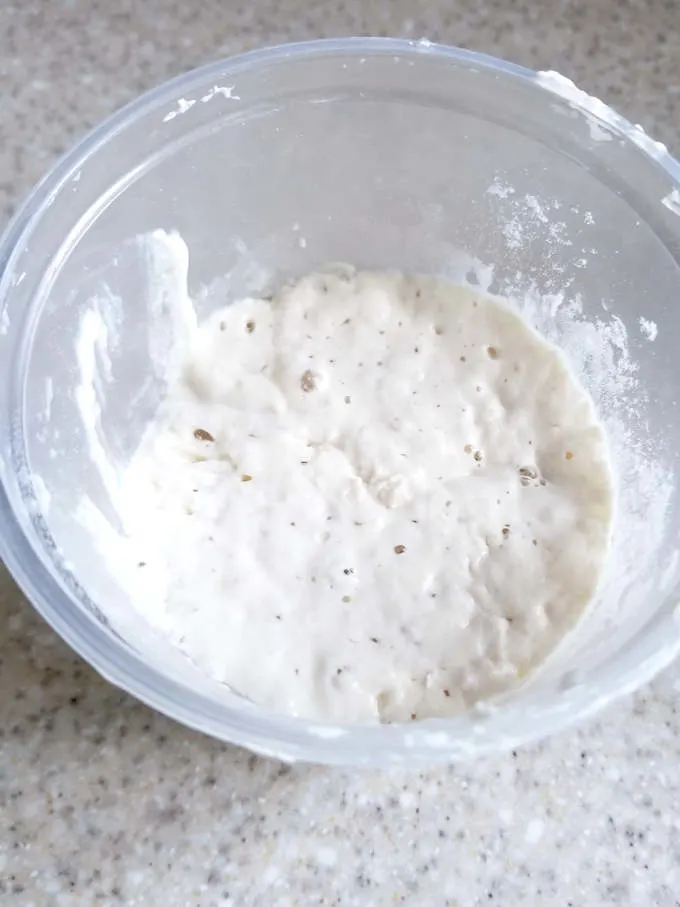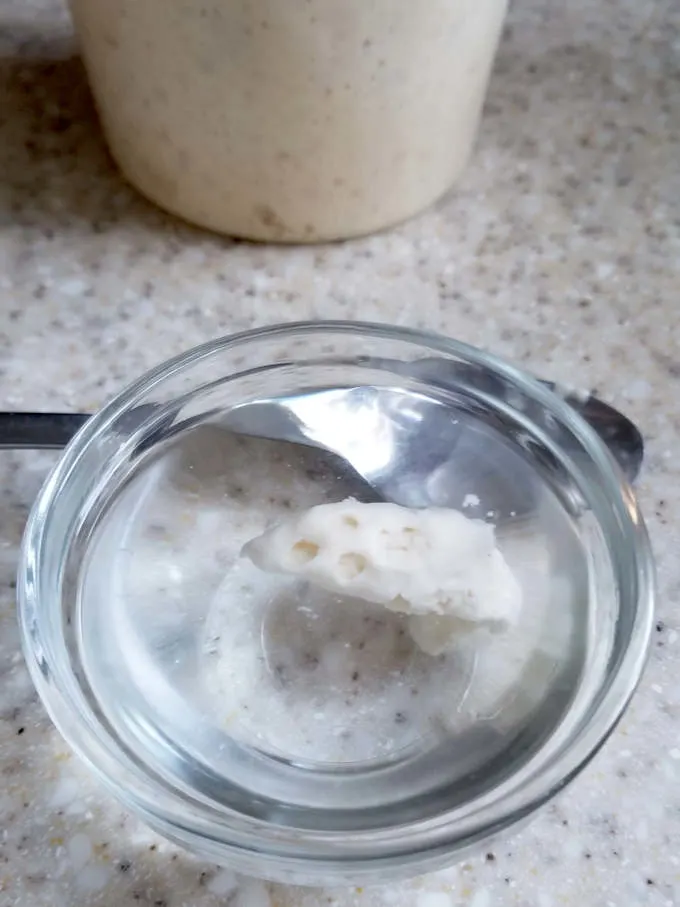Sourdough Croissants
These Sourdough Croissants are the best croissants ever! To have fresh Sourdough Croissants for breakfast, refrigerate them overnight and bake in the morning.

The difference between Classic Croissants and Sourdough Croissants is the use of the natural yeast in the starter to rise the dough. (You can use a smidge of commercial yeast to help you out, more on that later.)
If you don’t have one, check out my post to learn How to Make a Sourdough Starter. Then check out my system to Feed and Maintain Sourdough Starter. In the meantime you can go ahead and make those Classic Croissants with yeast.
I baked over 100 Sourdough Croissants before I was ready to post the recipe. The basic ingredients were not hard to nail down, I simply replaced some of the water and flour in the dough with sourdough starter and removed the yeast.


The biggest hurdle was keeping the dough warm enough to stay active, but not so warm that the buttery layers melt out of the dough. Well, that’s the challenge with any croissant recipe, but when working with sourdough is even more of a challenge.

What’s the secret to great Sourdough Croissants?
After several less than stellar batches, I finally decided that I had to treat this dough differently than classic croissant dough. Normally I would chill the dough after it’s mixed and chill it between each “turn”.
The problem with using that classic method is that each time I refrigerated the dough I slowed down the activity of the natural yeast and I could never get quite the poof I wanted in the final rise.
The first change I made was to add a hint of commercial yeast to the dough. Just a 1/2 teaspoon to help the dough stay active, but not so much that it would overtake the natural yeast or speed up the process too much. ***(See recipe note to make the recipe without commercial yeast.)
After 3 hours of fermentation the dough was beautifully soft, yet resilient. So I decided to skip the refrigeration step and move right into the lamination process.
Because the dough was soft, I let the butter warm up enough that it was a bit pliable, but still cool. This made it easier to roll the dough without the butter breaking apart.
Since the dough was so easy to work with I went right ahead and did the first two turns. I gave the dough a quick chill before the final turn and then a longer chill before rolling and cutting the dough.
Not only did this process cut a couple of hours from the total time, it also meant that my dough stayed nicely active. The dough was silky and alive. A good sourdough should feel alive in your hands.
The final step was to refrigerate the croissants overnight. In the morning I got up super early (the dogs help me here) and took the croissants out of the refrigerator.
Because my kitchen can be quite cool on a winter morning, I turned the oven on just for a minute to barely warm it up then turned it back off. (I wouldn’t need to do this in the summer.)
I put the trays in the oven and went back to bed (I’m not a morning person). When I got up a few hours later the croissants were ready to bake as soon as the oven was preheated.


Tips for making Sourdough Croissants:
- Your sourdough starter should be active when you mix the dough. It should pass the “float test”. Put a dollop of the active starter in water and it should float. If not, replenish your starter and wait until it’s active to mix the dough.
- If your kitchen is very cool, place the dough over a bowl of warm water or into a barely warmed oven during the fermentation time.
- If you find the butter is melting at any point during the lamination process, put in the the refrigerator briefly to chill.
- Brushing the dough with cool water before each fold helps create steam as the croissants bake. The steam will push the layers even higher for a bigger rise and flakier texture.
- The times in the recipe are estimates. The actual times will vary based on how active your starter is and the ambient temperature. The times will also be longer if you choose not to use the commercial yeast.

Over 100 croissants later, I can tell you that Sourdough Croissants have a depth of flavor that sets them apart from those made with commercial yeast. If you have a sourdough starter, I’m sure you know what I mean.
I know you hate to throw away that sourdough discard. Check out these recipes that use sourdough discard.
Are you a chocoholic? Me too. Use this dough to make decadent and delicious Chocolate Croissants. You’re welcome!
I’ve also got a recipe for almond lovers, Almond Filled Croissants are a little decadent and a lot delicious.
If you love this recipe as much as I do, I’d really appreciate a 5-star review.
Overnight Sourdough Croissants
Video
Ingredients
- 8 oz active sourdough starter (1 cup, 100% hydration)
- 10 oz whole milk (1 ¼ cups, scalded and cooled to 110 °F)
- ½ teaspoon dry yeast (optional, see note)
- 17 ½ oz unbleached all purpose flour (3 ½ cups, see note)
- 3 oz granulated sugar (⅓ cup)
- 2 teaspoons table salt
- 16 oz unsalted butter (pliable but still cool)
- 1 egg (for egg wash)
Instructions
- Make sure your starter is active and bubbly before using. If not, refresh the starter and wait until it's fully active before mixing the dough. Place 8 oz active sourdough starter, 10 oz whole milk, ½ teaspoon dry yeast (if using) and 2 cups (10 oz) of the flour in the bowl of a stand mixer with the paddle attachment. Mix to form a thick batter. If working by hand mix with a wooden spoon. Cover the bowl and let it rest for 30 minutes.
- Switch to the dough hook. Add 3 oz granulated sugar, 2 teaspoons table salt and remaining flour. Mix until the dough gathers on the hook and clears the sides of the bow, about 3-5 minutes on medium speed. l. If working by hand stir in as much flour as you can with a wooden spoon, then finish kneading in the rest of the flour by hand.
- Transfer the dough to a lightly oiled bowl, turning once to coat the dough. Cover the bowl and set it aside at room temperature. After 30 minutes uncover the bowl, lift one side of the dough over into the middle of the dough. Repeat with the other three sides of the dough then flip the dough over. Cover the bowl and after 30 minutes repeat the procedure. Cover the bowl and after 60 minutes repeat the procedure. Cover the bowl and after 60 minutes repeat the procedure one last time. By now the dough should be lively, elastic and airy. If the dough is still sluggish give it another hour or two at room temperature.
- While the dough is fermenting, prepare the butter package. Draw an 8" square in the center of a piece of parchment paper. Flip the paper over and set 16 oz unsalted butter in the middle of the square. Fold the parchment over the butter. Use a rolling pin or other heavy object (I use the flat side of a meat tenderizer) to flatten the butter to fill the 8"x 8" square. You can lift the paper if it sticks. Trim and rearrange the edges of the butter as needed. Fold the butter into the parchment and place in the refrigerator. 30 minutes before the dough is finished fermenting, remove the butter from the refrigerator. (If your kitchen is very warm, take the butter out 10 minutes ahead.) The butter should be firm and cool but a little flexible for layering into the dough.
- Turn the dough out onto a lightly floured surface. Do not knead out the air. Roll the dough to a 10" square. Once you have a square, roll from each of the four sides to form a 3" flap of the dough, leaving the center thicker than the flaps. You should end up with a square with four "flaps" coming out from the corners. Now it’s time to layer in the butter.
- Unwrap the butter and place it in the middle of the square. Fold the flaps so they overlap and enclose the butter, pinching in the corners as necessary to glue the seams together. You should now have an 8" square of dough with the butter enclosed. Use the rolling pin to gently press on the square to flatten it. Roll the dough to a 8" x 24" rectangle. Take your time to roll gently and evenly so the butter stays in one layer in the dough.
- Orient the dough so the long side of the rectangle is facing you. Brush off the excess flour. Brush the entire surface of the dough with cold water. Fold the right 1/3 of the dough towards the middle then fold the left 1/3 of dough over enclosing it like a letter. This is the first "turn".
- Orient the dough so the closed edge is on the top side and the open edge is facing you. Roll the dough again to an 8" x 24" rectangle. Brush off the excess flour. Brush the entire surface of the dough with cold water and again fold the dough like a letter. This is the second "turn". Set the dough on a sheet pan, cover with plastic and refrigerate at least 30 minutes.
- Remove the dough from the refrigerator and do a third turn exactly like the first 2. Wrap the dough and place it in the refrigerator for at least 2 hours.
- Line 2 baking sheets with parchment paper or a silicone baking mat. Roll the chilled dough to a 24” long x 16” wide rectangle. With the long side facing you, fold the top half of the dough over the bottom half to form a 24” long x 8” wide rectangle.
- Starting from the left, measure along the top edge of the dough and make a mark at 2”. Using a pizza cutter or sharp knife, make a diagonal cut from that mark to the bottom left edge of the dough. Save the piece that you cut off.
- Working from left to right, measure and mark 4” increments along the bottom edge of the dough. Working from left to right, measure and mark 4” increments along the top edge of the dough. You should have a pattern of one top mark between two bottom marks. Starting from the top left, make a diagonal cut to the next mark on the bottom edge, forming a triangle. Then cut from the bottom to the next top mark. Continue this pattern to cut 11 alternating triangles and one 1/2 triangle end piece. Save the 1/2 triangle piece you cut from the end of the dough.
- Unfold the triangles and cut each in half along the joint so you have a total 22 triangles. Unfold the 1/2 triangle pieces which you cut from either end. Pinch them together to form 2 more triangles.
- To form a croissant, hold a triangle from the wide base in one hand and gently stretch the width a little. Set the dough on the work surface with the narrow end pointing towards you. Roll the croissant towards the pointed end, holding on to the tip and gently tugging as you roll. Bend either end of the croissant towards the middle to form the crescent shape.
- Set the croissants on the prepared baking sheets, 3” apart. You should fit a dozen croissants per half sheet pan. Cover with plastic wrap and set in the refrigerator overnight. (see note)
- In the morning. Take the croissants out of the refrigerator. Allow them to proof at room temperature for 2-3 hours. The exact time needed for proofing will vary depending how active your starter was and the temperature of your kitchen. They should be at least 50% larger than they started and feel airy and puffy. Preheat the oven to 400 °F. Brush the croissants with egg wash. Bake the croissants until golden brown, 15-20 minutes. Serve warm or room temperature.
Would you like to save this recipe?
As an Amazon Associate and member of other affiliate programs, I earn from qualifying purchases.









Hi Eileen,
Thank you for the recipe! Do you use active dry yeast or instant yeast?
Thanks again!
Whatever I happen to have on hand. Usually active dry.
Hi Eileen,
My office baking expert recommended your website and I am so thankful for the recommendation. I enjoyed going through your baking lessons one by one and I made your sourdough bread, pretzel, pita and hamburger buns. Thank you.
I tried to make the croissants this past weekend. My dough looked fabulous until lamination: I took the dough out of the fridge to roll it out and it was very tight, very firm and very springy. I was barely able to stretch it wide enough for my butter layer, and even then I stretched it out in the air like a pizza dough, instead of rolling it out. Rolling just didn’t work.
Needless to say, none of my lamination turns were easy. I wasn’t able to stretch it out for the last fold and I just folded it on itself with a sigh. I managed to cut and roll them in a dense croissant like shape but they didn’t proof at room temperature and unrolled in the oven. The layers looked great, but the dough didn’t have any spring to it, it rather looked like piles or flat, buttery vol-au-vent.
I used all purpose unbleached flour. I don’t know how old the flour was, could that have made a difference?
Any idea what else I could have done wrong?
Also if you are looking for a new challenge, I would love a sourdough vol-au-vent pastry recipe… 🙂 Cheers!
You said “I took the dough out of the fridge to roll it”… Did you refrigerate the dough before beginning lamination? I have better results when I go directly from fermentation to lamination. With the milk and sugar in it, this dough is usually pretty supple. Did you knead the dough after it was mixed? The recipe has you mix the dough just until it comes together without additional kneading. Unbleached ap flour is exactly what I use. Unless the flour is rancid, the age doesn’t matter. At any point in the process if the dough gets really springy a 30 minute rest in the fridge will give it some slack.
Hi,
I would love to try this recipe but I am vegan. Any success with vegan butter?
Thanks,
I personally don’t have experience using vegan butter, but here is a quote from a previous comment on this recipe “We are vegan, so we used soy milk and vegan butter for the dairy products and I used a oil wash instead of an egg wash. These are so good!”.
I’ve made these twice (well, I’m in the middle of the second time now). Both times I’ve found that as soon as I start rolling things out with the butter inside, the butter oozes out the edges and gets all over the rolling pin, all over the counter, all over my hands. After the first turn or two, as the layers of dough get thinner, it starts escaping from the middle of the sheet as well as the edges. Any suggestions as to what I’m doing wrong, or is this just what happens when you make croissants?
Some differences that might explain it: I’m using mostly bread flour (with a little whole-wheat), rather than all-purpose because I didn’t happen to have any all-purpose in the house. And I’m making a half batch, so the rolling measurements needed to be reduced, e.g. a 6″x6″ square rather than 8″x8″. Is halving the recipe just a doomed exercise?
Start with butter that is chilled enough that it is firm but is slightly pliable. If your butter is oozing it must be too warm.
Followed this recipe and they came out PERFECT! Drizzled some chocolate on a few and they were so yummy!